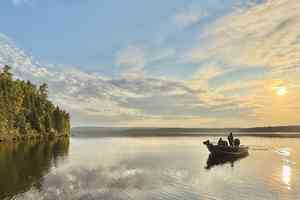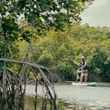Tossing a concerned gaze downstream, and with a gesturing hand loosely gripping the thick agricultural air of the Shenandoah Valley, Jerry Black, a native and lifelong resident of the Valley, spoke hope for the future of Beaver Creek and the Chesapeake Bay Watershed.
“This water—all of it—ends up in the Bay, and what we do right here impacts it.”
Such responsible watershed thinking, in an area plagued by environmental transgressions, left me stunned.
Beaver Creek, an intimate spring creek that rises in the Shenandoah Valley near the small farming community of Ottobine, doesn’t look like much. In many places, it’s less than a rod-length wide, and is hardly noticeable—just a crease in the working landscape.
A half century or more ago, when the natural landscape was a bit more virgin, Beaver Creek was a respectable native trout stream.
“Old timers used to tell me about catching big brook trout in here. I mean big ones. Fish up to 16 inches,” Jerry waxed.
In those days, the North River—which drains Beaver Creek and joins the South River at Port Republic to form the South Fork of the Shenandoah River—was a bit less tarnished, too. Now the river sees a fish kill almost every year, the result of agricultural runoff from the massive volume of irresponsible conventional poultry farming within its drainage.
Despite its height in the watershed, Beaver Creek too began to deteriorate as a result of poor land-use practices. The 16-inch natives went away, and the creek became silted and warm, uninhabitable by coldwater creatures.
In 1999, Jerry was elected President of the Massanutten Chapter of Trout Unlimited, and was subsequently approached by Bob Cramer, a local guide, who knew the potential that Beaver Creek had as a fishery.
“Bob told me that we ought to do something, and it kinda took off from there,” said Jerry. “I was president for four years, and it took me five years to talk to all the landowners. Doug Michael, who used to own the country store down the road, was excited about it and talked to landowners, too. They were all very into it—getting the cows out of the creek and such.”
“You didn’t run into any kind of heel-digging? From farmers, I mean.” I asked, still somewhat stunned.
“We all grew up together. Judge Paul, he lives just downstream,” Jerry said, waving towards the forested boundary of his property.

“There was one older lady, though—Mrs. Auville—that owned the middle property,” Jerry said, digging deeper. “She was a little…stuck in her ways…and let cows run all over the creek. That’s just the way she’d always done it. But she died and Mr. Zimmerman acquired the property and agreed to fence the cattle out, and we’ve planted trees on the hill, there.”
With all the landowners on board, Jerry had an agreement penned by a lawyer and passed around to the landowners of Beaver Creek, signifying a united effort to keep the creek clean and work towards a sustainable coldwater fishery.
Today, the creek is open to the public, but pressure is limited by a first-come first-serve-type permitting process run through the Ottobine country store, the one Doug Michaels owned when the project was getting off the ground. Anglers will find that sizeable stocked rainbows fin the water, and that stream-born, wild rainbows are caught on occasion. Even the brook trout have made a comeback. Local schools participate in Trout Unlimited’s Trout in the Classroom program, and release their brook trout into the creek, teaching watershed thinking to the next generation of citizens, and Project Healing Waters holds events on the creek, using it to heal wounded war veterans.
“A cleaner creek helps the economy, the local fishing. I can’t imagine any landowner not wanting to go for it,” said Jerry. “They were really glad to see Project Healing Waters use the creek.”
![Jerry Black [left] and Sam Zimmerman [right] (Photo: Matthew Reilly). beaver creek ottobine va](https://www.hatchmag.com/sites/default/files/styles/preload/public/styles/extra-large/public/field/image/DSC_0113.jpg?itok=eyCn0H7X)
Just then, the hum of a dust-coated John Deere came into view carrying glasses, a straw hat, and Sam Zimmerman, the local farmer that took over Mrs. Auville’s property after she passed. Jerry met him with enthusiasm, as a longtime friend.
Sam proudly announced to Jerry that he had just joined the local Trout Unlimited chapter, and was excited to help work on the creek. He was planning to take his daughter fishing later that afternoon. It was her birthday.
“It’s great to have a place right at the edge of the property that I can take my kids to enjoy where we live,” said Sam.

Jerry and Sam took off for the grassy knoll that overlooks the middle stretch of the river, as Sam was prepared to till a garden for Jerry, leaving me to get back to the cold water of the creek, searching with a small weighted nymph for one of the wild rainbows that speaks to the success and environmental mindfulness of this watershed and its people.
Behind me on the knoll sits Jerry’s soon-to-be-completed home—a sparkling new log structure finished with a chimney of river rock from a river drainage just up the valley—set against the backdrop of a bluebird Shenandoah Valley sky. On the face of the chimney is a stone-carved trout, of which Jerry is very proud. Together, they overlook the creek and all those that come to fish it—a symbol of how far it has come, and an inspirational model for all fisheries, creeks, and communities like it.





























Comments